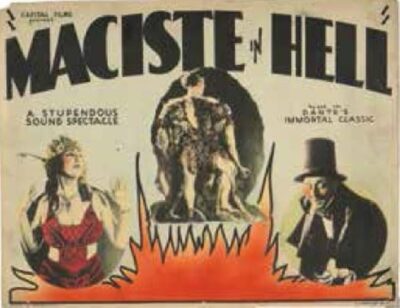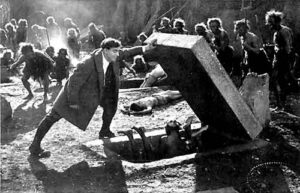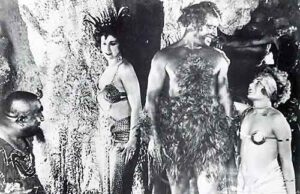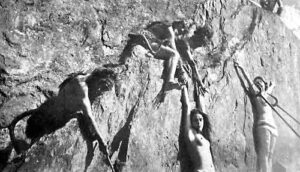A monument of silent era Italian cinema, and one of the screen’s most indelible depictions of Hell. Inspired by the “Inferno” portion of Dante Alighieri’s DIVINE COMEDY, MACISTE IN HELL (Maciste all’inferno; 1925) followed several Italian made filmic depictions of the same source material (including 1911’s L’INFERNO) and preceded a similarly titled 1962 film by director RIccardo Freda.
MACISTE IN HELL (1926) Trailer
The Dante reference will likely be more recognizable to modern-day audiences than the film’s other major connection: Maciste, an Italian cinema mainstay since the character’s initial appearance in CABIRIA (1914). A synonym for “Hercules,” Maciste was played by the beefy Bartolomeo Pagano (1878-1947), who incarnated the character in 26 more films during the years 1915-1926, with MACISTE IN HELL being one of Pagano’s last go-arounds before his late 1920s retirement.
The film was initially released in an hour-long abbreviation, prepared by Italian censors who found the original 96-minute cut too salacious. For much of its lifespan that abbreviation was the only available version, but in 2019 a restoration was undertaken by Rainwater Renaissance, with digital swabbing and color tinting added to a version that can be safely proclaimed the only cut of MACISTE IN HELL worth viewing.
The inferno depicted here is governed by a complex and depraved hierarchy (the detailing of which was excised from the hour-long version) patterned after the Roman Court. At its center is Pluto (Umberto Guarracino), the King of Hell, who intently watches the doings of Earthlings through a magic mirror. He’s particularly obsessed with the impossibly strong and virtuous Maciste (Bartolomo Pagano), who Pluto regards as “the champion of good and therefore our enemy!”
Pluto orders Barbariccia (Franz Sala), the “lieutenant of the devils,” to capture Maciste. After crossing the River Styx, Barbariccia and his envoys enter the Earthly plane and assume human form. They head to Maciste’s house and attempt to bribe him, but of course he’s not easily swayed, leading Barbariccia to turn his attention to the pretty Graziela (Pauline Polaire), with whom Maciste is besotted. Barbariccia distracts Maciste and kidnaps Graziela’s infant son, who nonetheless ends up in “safe hands”—Maciste’s, after which he tries to fight Barbariccia and ends up in Hell.
In this environ Maciste is surrounded by pitchfork wielding demons who want to torture him. He manages to fight them off before being ushered into Pluto’s palace. Apparently, no living human can remain in Hell for more than three days unless that person kisses a woman, a rule Pluto seeks to use to entrap Maciste, but apparently, “even in Hell woman is fickle,” with willing participants proving difficult to find.
Maciste, meanwhile, becomes determined to save Hell’s damned souls. He beats up a torturer and allows several souls to escape their confinement, until being approached by Pluto’s besmitten daughter Luciferina (Lucia Zanussi). She leads Maciste on “Hell’s aeroplane”—the back of a flying dragon—to Pluto’s headquarters, where she gets him to kiss her, thus transforming him into a demon.
All this occurs as Barbariccia is leading an uprising against Pluto. Given that Maciste is now a demon, he has superhuman strength, and uses it to his advantage, capturing and incapacitating Barbariccia and convincing Pluto to allow Maciste back onto the Earth. But there’s still trouble afoot in the form of Proserpina (Elena Sangro), Pluto’s hot-to-trot wife and “the greater headache of the very peaceful King.”
The inferno depicted in this film is one of the most impressive on record, a studio-bound fantasy netherworld as lush and expansive as those of METROPOLIS (1927) and the aforementioned CABIRIA. Contained are many indelible images, including an impressive overhead shot of dozens of demons circling Maciste, a panoramic depiction of tortured souls baking on a boiling plain and the sight of Pluto’s debauched inner chamber, packed with scantily clad women, that horrified 1920s-era censors. The groundbreaking-for-their-time special effects remain startling, with early stage Claymation and jump cuts utilized to strong effect; the sight of a headless man placing a severed head on his neck remains startling, even if its methodology is longer very novel.
The inferno-set scenes stand in stark contrast to the supposedly naturalistic Earthbound sequences, which are bland and unexciting. Furthermore, director Guido Brignone drags these scenes out for far too long (52 minutes in the restored version), imparting a dull love triangle that has no bearing on the film’s later, and more impactful, events.
Vital Statistics
MACISTE IN HELL (Maciste all’inferno)
Fert-Pittaluga
Director: Guido Brignone
Producer: Stefano Pittaluga
Screenplay: “Fantazio” (Ricardo Artuffo)
Cinematography: Massimo Terzano, Umberto Arata
Editing: Guido Brignone
Cast: Bartolomo Pagano, Pauline Polaire, Elena Sangro, Lucia Zanussi, Franz Sala, Umberto Guarracino, Mario Sajo, Domenico Serra




